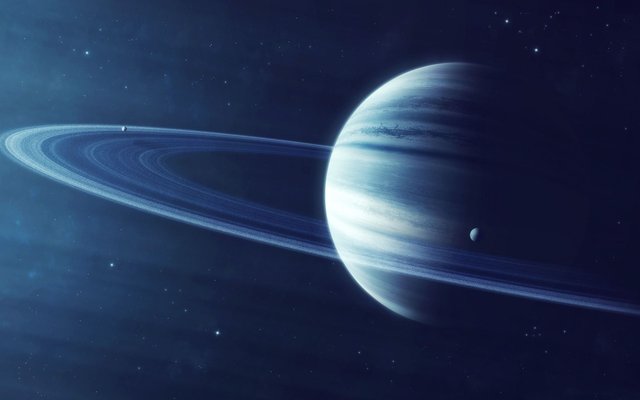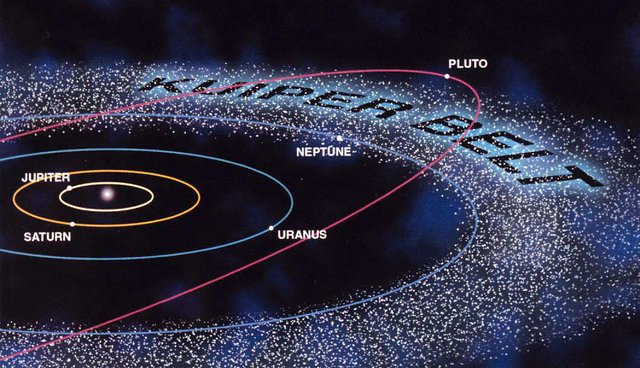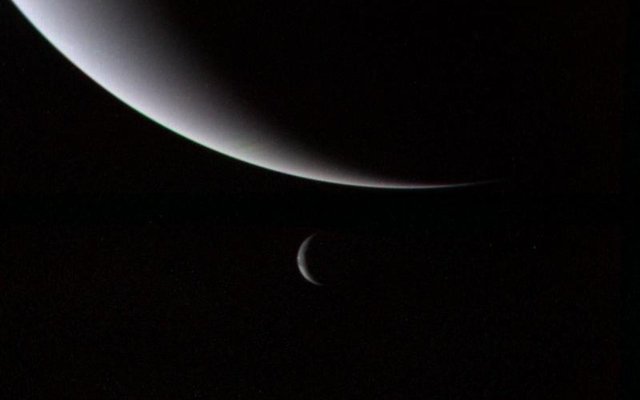A few things about Neptune
Beside our earth there is a second blue planet in our solar system and it is damn far away from the sun. The first time you look at Neptune, you might think that it is covered with water. Therefore the planet has its name from the roman god Neptune and corresponds to the greek water god Poseidon and was originally probably the god of the flowing waters, the jumping springs or even of the weather. This is because first it used to be believed that Neptune was an ocean planet. Unfortunately there are no huge oceans on this distant planet. Neptune consists almost completely of gas. Because of its large amount of methane, this gas shimmers blue.
The light can be split into several colors, which you probably know from a rainbow. Methane has the property to fade out the red part of the light, what remains is blue. Methane is by the way also the gas which is expelled by many living beings in large quantities.
As far as we know, Neptune is the most distant planet in our solar system with 4.5 billion kilometers. Its orbit around the sun is almost circular and its distance to it is between 29.709 and 30.385 astronomical units. Its diameter is 50,000 kilometers and thus it has almost 5 times the mass of the earth and is also the fourth largest planet in the solar system. Neptune rotates around its own axis in 15 hours, 57 minutes and 59 seconds, this making the gas planet one of the fastest rotating planets.
On earth a year lasts 365 days, everybody knows that. But on other planets it looks quite different because they move around the sun at different speeds. Neptune needs 165 earth years to rotate once around the sun, which means that a Neptune year takes 165 earth years or almost 60,000 earth days. Only one Neptune year has passed since Neptune was discovered in the 19th century.
Galileo Galilei was the first one to use telescopes to explore the sky. He made pioneering discoveries such as the four large Jupiter moons. Even the farthest planet, Neptune, he got in front of the lens. But the planet had only been so weak that Galileo Galilei thought it was a star what he see. In 1846, however, Neptune became mathematically calculable due to orbital disturbances of Uranus and then Neptune was discovered by the astronomer Johann Gottfried Galle.
Known for its storms is in the solar system mainly Jupiter but also on Neptune there are gigantic storms. The largest storm was called the Great Dark Spot and covered almost 13,000 kilometers. This one was even a little bigger than the whole earth. In 1994, however, it was discovered that the spot had disappeared. Apparently it just disappeared as storms on the earth do at some point.
The moon of the earth was probably created by splinters. This is not possible with gas planets, because there is no stone that could split off from them. So Neptune probably captured his moon Triton. Maybe Triton was once a dwarf planet like Pluto and was then thrown into the clutches of Neptune's gravity by a collision. In the Kuiper Belt, which comes after Neptune, there are all sorts of rocks and tiny planets floating around. It could therefore happen that Neptune could get one or the other moon in the course of its evolution. So far we know of 14 Neptune moons. Besides the moons, Neptune also has a ring system that is so fine and dark that you can't always spot it.






This post has received a 18.59% upvote from @swiftcash, thanks to @msg768 🤑
Hello @oendertuerk I do not even want to think what would happen if Neptune got a spark.
Greetings @oendertuerk, there are things I did not know thanks for sharing...
Excellent post as always!
ty @klein7